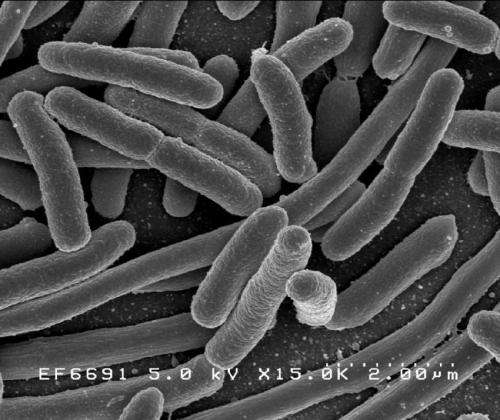Fighting E. coli with E. coli

According to findings published this week in mBio, Nissle, a strain of Escherichia coli, is harmless to intestinal tissue and may protect the gut from enterohemorrhagic E. coli, a pathogen that produces Shiga toxin.
E. coli has gotten a bad rap because a few pathogenic strains can cause severe, even life-threatening, symptoms. But for more than a century, the commensal strain Nissle has been used as a probiotic and, more recently, to treat intestinal disorders including ulcerative colitis.
Researchers at the University of Cincinnati wanted to understand whether Nissle could also protect intestinal tissue against EHEC and other pathogens. They studied the probiotic’s protective effects using human intestinal organoids, or HIOs, which are experimental models of real tissue derived from stem cells.
The researchers first injected the HIOs with Nissle and observed that the bacterium was harmless: It did not damage the epithelial barrier, formed by the protective outer layer of the organoid. Next, in separate experiments, they injected HIOs with enterohemorrhagic E. coli or EHEC. This pathogen produces Shiga toxin, which sickens millions and kills thousands of people—mainly children—every year. The EHEC quickly broke down the epithelial barrier in the HIOs.
Then, the researchers pre-treated HIOs with Nissle and, 12 hours later, injected them with EHEC. This is where the Nissle proved to be protective: Even though the EHEC proliferated in the organoid tissue, it did not destroy the epithelial barrier. During the same time, the Nissle population declined rapidly in the tissue. The researchers observed the same effects when they injected pre-treated HIOs with uropathogenic E. coli, the strain responsible for the majority of urinary tract infections.
“Basically, the Nissle was killed by the pathogenic bacteria, but it made the intestine able to withstand damage better,” said molecular geneticist Alison Weiss, Ph.D., who worked on the study together with Suman Pradhan, Ph.D., a research associate in Weiss’s lab.
The results suggest Nissle may confer benefits not by inhibiting the pathogenic strains directly, but instead by harnessing defense mechanisms in the cell itself, and that the probiotic may help prevent severe EHEC infections. However, the results also suggest that Nissle can be vulnerable to phages from the Shiga toxin, which would limit the probiotic’s usefulness as a therapeutic. Weiss cautioned that more studies are needed to better understand the complex interactions of bacterial species in a real-world setting.
Weiss’s research focuses on bacteria that produce the Shiga toxin, like EHEC. “It’s really bad,” she said. “My whole career, I’ve been interested in preventing pediatric pathogens. Once these kids get EHEC, all you can do is give them fluids and support them. There’s nothing else we can do.”
Weiss is excited by the potential of using HIOs as a model for better understanding intestinal conditions. “They’re a huge breakthrough,” she said. “A lot of intestinal pathogens are species-specific, and organoids are really good for looking at early events.”
Source: Read Full Article
